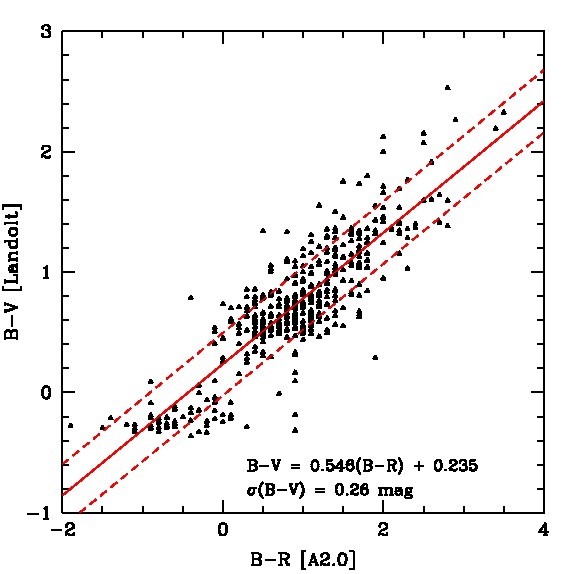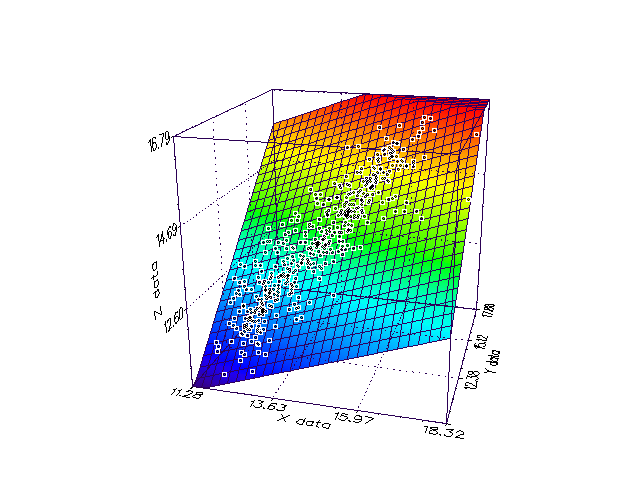Deriving V Magnitudes from USNO-A2.0 Photographic Photometry
Eric Mamajek (U. Rochester)
Last updated: 26 April 2010
The USNO-A2.0 catalog (Monet et
al. 1998) provides photographic magnitudes in a blue "B" and red
"R" band. These magnitudes were derived from conversions between Tycho
BV photometry and photographic photometric systems for various
emulsions (O, E, J, F, etc.) constructed by Arne Henden (see documentation
on the photometric calibration of USNO-A efforts). For some
references for photometric conversions between various systems, see Seiichi
Yoshida's Magntiude Systems and Color Conversions webpage. I was
interested in some simple relations to convert the photographic
magnitudes into standard V mangitudes (despite the sizeable
uncertainties that typically accompany photographic photometry). Based
on a (now defunct) website posted by Project Pluto, I had been
previously using the following relations: VJohnson =
0.375*BA2.0 + 0.625*RA2.0, and
(B-V)Johnson = 0.625*(B-R)A2.0.
I cross-referenced 678 unique UBVRI photometric standard stars from
Landolt (1992,
2007)
and Landolt & Uomoto (2007)
with the USNO-A2.0 catalog to determine photometric conversions
between the USNO-A2.0 photographic photometry and the standard system
defined by Landolt. The Landolt UBVRI photometry is ultimately
traceable to the UBV photometric system of Johnson &
Morgan (1953) and the RI system of Cousins
(1976) (see discussion in Landolt
1992). The coordinates from Landolt's papers were queried against
the USNO-A2.0 catalog using Vizier, adopting a 10" search radius. To
minimize against the effects of neighboring stars and
misidentifications, I selected only those stars that had a single,
unique match A2.0 entry within 10", and those that were not
flagged as "ACT" (i.e. bright stars in the Tycho catalog, as one would
not bother with photographic magnitudes for these brighter stars).
Some of the Landolt standards are fast-moving proper motions stars,
but no attempt was made to track down stars that had moved more than
10" between the USNO-A2.0 mean epoch and the epoch quoted by
Landolt. I found 448 convincing matches between Landolt's standard
list and an entry in the USNO-A2.0 catalog with a useful B and R
magnitude listed. I did a linear Z(X,Y) fit to these data and found
that 6 stars were clear statistical outliers using Chauvenet's
criterion (there were most likely stars with incorrect A2.0
counterparts). After this single round of clipping, I derived the
following color-magnitude relations based on the photometry for the
remaining 442 Landolt standards:
VLandolt = 0.429 + 0.325*(BA2.0) + 0.654*(RA2.0)
{range: 11.6 < B < 18.0, 10.0 < R < 17.5 ; rms = 0.35 mag}
(B-V)Landolt = 0.546*(B-R)A2.0 + 0.235
{range: -1.5 < (B-R) < 3.5 ; rms(B-V) = 0.26 mag}

Top plot: A2.0 B-R color vs. Landolt B-V color. Clearly there is a discontinuity around ~A0 where B-V ~ 0.

Bottom plot: 3D plot showing USNO B magnitude on the X-axis, USNO R magnitude on the Y-axis, and Landolt V magnitude on the Z-axis.

